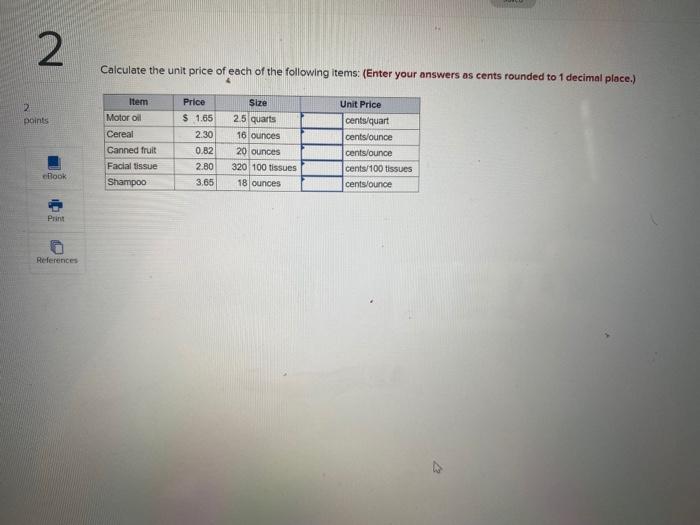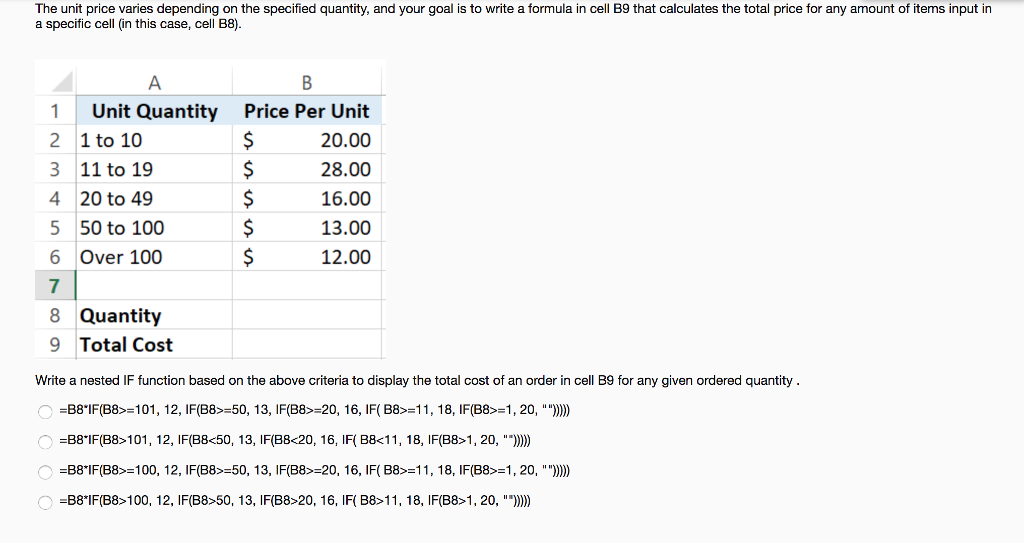Calculate The Unit Price Of Each Of The Following Items

A simple task, calculating the unit price of items, often overlooked, remains a cornerstone of informed consumerism. From grocery store aisles to online marketplaces, understanding how to determine the true cost per unit empowers shoppers to make financially sound decisions. This seemingly basic calculation can unlock substantial savings and promote greater awareness of spending habits.
At its core, unit price calculation involves dividing the total price of a product by the number of units it contains. This allows consumers to compare the costs of differently sized packages or brands on an equal footing. Mastering this skill is crucial for anyone seeking to optimize their budget and avoid falling prey to misleading marketing tactics.
Why Unit Price Matters
The significance of unit price calculation extends far beyond simple cost comparisons. It is about becoming a discerning consumer and resisting the psychological tricks retailers often employ. Larger packages, for instance, may seem like a better deal at first glance, but a quick calculation might reveal a higher cost per unit compared to a smaller, seemingly more expensive option.
This skill is particularly beneficial in categories with frequent bulk discounts or promotions. By accurately calculating the unit price, shoppers can determine whether these deals truly offer savings. It also allows consumers to make informed decisions about whether to buy in bulk, based on their consumption habits and storage capabilities.
Furthermore, calculating unit prices fosters a greater understanding of the value of products. It encourages consumers to think critically about their spending and appreciate the relationship between price and quantity. In a society often bombarded with advertising and marketing messages, the ability to discern true value is invaluable.
How to Calculate Unit Price
The formula for calculating unit price is straightforward: Total Price / Number of Units = Unit Price. To apply this effectively, consider the following examples:
Example 1: Comparing Cereal Boxes
Imagine you're choosing between two boxes of cereal. Box A costs $4.50 and contains 18 ounces. Box B costs $5.00 and contains 20 ounces. Which is the better deal?
To calculate the unit price for Box A: $4.50 / 18 ounces = $0.25 per ounce. For Box B: $5.00 / 20 ounces = $0.25 per ounce.
In this scenario, both boxes have the same unit price, so the choice comes down to preference or other factors like brand loyalty. If one of the unit prices had been lower, it would have clearly represented the better value.
Example 2: Bulk vs. Individual Purchases
Consider buying paper towels. A single roll costs $2.00. A pack of 6 rolls costs $10.00. Is buying the pack a better deal?
The unit price for a single roll is simply $2.00. The unit price for the pack of 6 is $10.00 / 6 rolls = $1.67 per roll.
In this case, purchasing the pack of 6 rolls offers significant savings per roll. This illustrates how seemingly more expensive bulk purchases can often provide better value in the long run.
Tools and Resources
While calculating unit price is not complex, several tools and resources can simplify the process. Many grocery stores now display the unit price directly on shelf tags, saving consumers the effort of manual calculation. Online retailers also frequently provide unit price information, enabling easy comparisons across different products.
Numerous mobile apps and websites are designed to assist with unit price calculations. These tools allow users to input the price and quantity of items, instantly providing the unit price and often offering comparisons to similar products. These digital aids can be especially helpful when shopping in unfamiliar stores or comparing items with varying units of measure.
Furthermore, several personal finance websites offer articles, tutorials, and calculators to help consumers understand and apply unit price calculations effectively. These resources provide valuable insights into smart shopping strategies and overall financial literacy.
The Impact on Society
Promoting widespread adoption of unit price calculation can have a positive impact on society. Empowered consumers are less likely to be taken advantage of by deceptive pricing practices. They also have more control over their budgets, leading to improved financial well-being. Greater transparency and fairness in the marketplace can boost consumer confidence and drive more responsible spending habits.
Moreover, a focus on unit price can encourage businesses to compete on value rather than simply on packaging or branding. This could lead to more efficient production processes and lower prices for consumers. A society that prioritizes informed decision-making benefits both individuals and the economy.
In conclusion, while seemingly simple, calculating the unit price is a powerful tool for empowering consumers. By embracing this skill, individuals can take control of their spending, make informed purchasing decisions, and contribute to a more transparent and equitable marketplace. The ability to determine true value is an essential life skill in today's complex consumer landscape.


![Calculate The Unit Price Of Each Of The Following Items [ANSWERED] Find the unit price of each of the following items. Round](https://media.kunduz.com/media/sug-question/raw/53295444-1657914207.3376033.jpeg?h=512)
